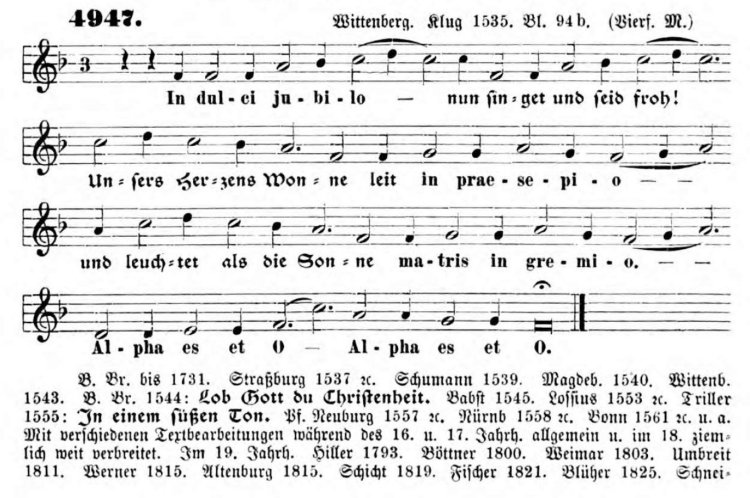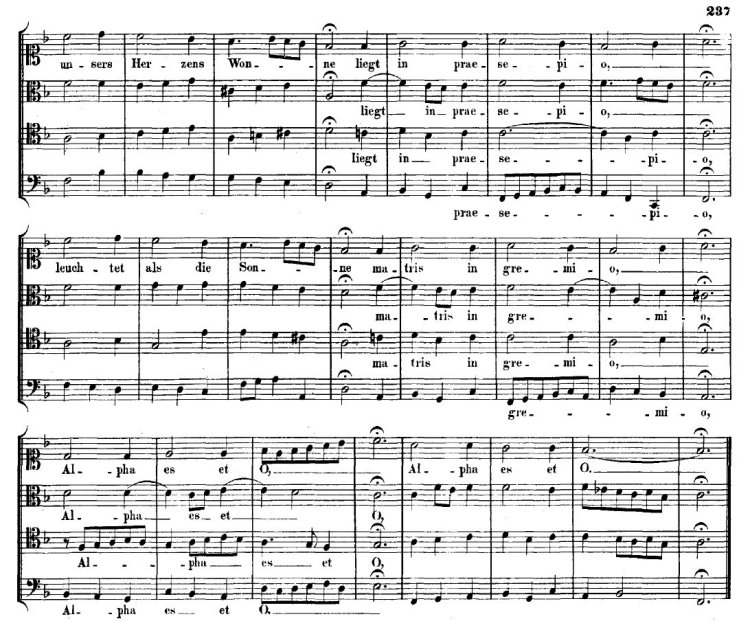|
Chorale Melodies used in Bach's Vocal Works
In dulci jubilo |
|
Melody & Text | Use of the CM by Bach | Use of the CM by other composers |
| |
|
Melody & Text: |
|
In dulci jubilo ("In sweet rejoicing") is a traditional Christmas carol. In its original setting, the carol is a macaronic text of German and Latin dating from the Middle Ages. Subsequent translations into English, such as J.M. Neale's arrangement "Good Christian Men, Rejoice" have increased its popularity, and Robert Pearsall's 1837 macaronic translation is a mainstay of the Christmas Nine Lessons and Carols repertoire. J.S. Bach's chorale prelude based on the tune (BWV 729) is also a traditional postlude for Christmas services.
The original song text, a macaronic alternation of Medieval German and Latin, is thought to have been written by the German mystic Heinrich Seuse circa 1328. According to folklore, Seuse heard angels sing these words and joined them in a dance of worship. In his biography (or perhaps autobiography), it was written:
Now this same angel came up to the Servant (Suso) brightly, and said that God had sent him down to him, to bring him heavenly joys amid his sufferings; adding that he must cast off all his sorrows from his mind and bear them company, and that he must also dance with them in heavenly fashion. Then they drew the Servant by the hand into the dance, and the youth began a joyous song about the infant Jesus ...
|
|
Melody: Zahn 4947
Composer: Anon (c1400) |

 |
|
The tune first appears in Codex 1305, a manuscript in Leipzig University Library dating from c1400, although it has been suggested that the melody may have existed in Europe prior to this date. In print, the tune was included in Geistliche Lieder, a 1535 Lutheran hymnal by Joseph Klug. It also appears in Michael Vehe's Gesangbuch of 1537. In 1545, another verse was added, possibly by Martin Luther. This was included in Valentin Babst's Geistliche Lieder, printed in Leipzig. The melody was also popular elsewhere in Europe, and appears in a Swedish/Latin version in the 1582 Finnish songbook Piae Cantiones, a collection of sacred and secular medieval songs.
The tune appears in several collections by Michael Praetorius, for voices only: Musae Sionae II (1607) no. 5, a motet à 8 for double choir; Musae Sionae V (1607) nos. 80-82 (for 2, 3 or 4 voices); Musae Sionae VI (1609) nos. 28, 29, 31 resp. 32, 33 all for 4 voices; and 5 part setting from Musae Sionae VI (1597). And a vocal–instrumental version from his collection Polyhymnia Caduceatrix et Panegyrica (1618-1619), No 34: a festive multi-choir version with large instrumental support including trumpets and timpani. It can be executed by 7, 12, 16 or 20 voices in 5 choirs (three vocal, one chapel- and one instrumental choir) and general bass. The Praetorius settings were widely adapted in Protestant continental Europe.
A polyphonic arrangement for 8 voices was made by Robert Lucas de Pearsall (1795-1856), this being later adapted for 4 voices, the most commonly performed version, by W. J. Westbrook (1831-1894). |
|
Text: In dulci jubilo (EKG 26)
Author: Heinrich Seuse (c1328) |
|
There have been a number of translations of the Latin/German poem into English. The most popular that keeps the macaronic structure is R. L. de Pearsall's 1837 translation, which retains the Latin phrases and substitutes English for German. A 2008 survey by BBC Music Magazine found this to be the second most popular choral Christmas carol with British cathedral organists and choirmasters.
Alternatively, a looser translation produced in 1853 by John Mason Neale titles the work "Good Christian Men, Rejoice". This translation is often criticised; Thomas Helmore made a mistake when transcribing the mensural notation of Piae Cantiones which led to the repeated "News, news" and "Joy, joy" phrase. In 1921, H. J. Massé wrote that it was an example of "musical wrong doing ... involving the mutilation of the rhythm of that grand tune In dulci jubilo to the English words Good Christian Men Rejoice. It is inconceivable that anyone of any real musical culture should have lent himself to this tinkering with a perfect tune for the sake of fitting it perforce to works of inferior merit." He goes on to cite a more appropriate English translation from 1567 by John Wedderburn as a more "worthy effort". Jeremy Summerley in his radio documentary series A Cause for Caroling is more complimentary, saying that the mistaken repeated note is what makes that version of the tune memorable.
Still another English translation, made in the 19th century by Arthur T. Russell and featured in several Lutheran hymnals, renders the work as "Now Sing We, Now Rejoice".
Source: In dulci jubilo
(Wikipedia) (August 1, 2018) |
| |
| |
|
Use of the Chorale Melody by Bach: |
|
J.S. Bach set this melody several times: as a chorale in BWV 368; and then for organ in BWV 608 as a double canon in his Orgelbüchlein and in BWV 729 and BWV 751 as a chorale prelude. Commentators agree, however, that BWV 751 is too simple and undeveloped to be the work of J.S. Bach. J.S. Bach also used the opening phrase of the melody as a fugal subject for two other choral preludes, BWV 703 (Gottes Sohn ist kommen) and BWV 724 (Gott durch deine Güte). BWV 729, written by J.S. Bach to accompany congregational singing in Arnstadt, is traditionally performed as the first organ voluntary at the end of the Festival of Nine Lessons and Carols at King's College, Cambridge. This voluntary was first introduced to the service in 1938 by organ scholar Douglas Guest. |
|
Text: In dulci jubilo |
|
Chorale In dulci jubilo, BWV 368
Ref: Ri 143; Br 143; Birnstiel 150; AmB 46II p.104; Levy-Mendelssohn 8; Fasch p.46; Penzel 127; BC BC F110.1 |

 |
|
Untexted: |
|
Chorale Prelude In dulci jubilo (I), BWV 608 |
| |
|
Chorale Prelude Gottes Sohn ist kommen, BWV 703 |
| |
|
Chorale Prelude Gott, durch deine Güte (Gottes Sohn ist kommen), BWV 724 |
| |
|
Chorale Prelude In dulci jubilo (II), BWV 729 |
| |
|
Chorale Prelude In dulci jubilo (III), BWV 729a |
| |
|
Chorale Prelude In Dulci Jubilo (IV), BWV 751 [by Johann Michael Bach] |
| |
| |
|
Use of the Chorale Melody by other composers: |
|
Dietrich Buxtehude set the melody as a chorale-cantata in 1683 for soprano, alto and bass accompanied by two violins and continuo (BuxWV 52) and as a chorale prelude for organ (BuxWV 197) c1690.
Franz Liszt included the carol in his piano suite Weihnachtsbaum in the movement entitled Die Hirten an der Krippe (The Shepherds at the Manger). Norman Dello Joio uses the theme as the basis of his "Variants on a Medieval Tune" for wind ensemble. Ronald Corp composed a setting of In Dulci Jubilo for unaccompanied SATB choir in 1976.
Gustav Holst included both Good Christian Men, Rejoice and God Rest You Merry, Gentlemen in his 1910 Christmas Day choral fantasy (Neale version, 1853), with accompaniment for orchestra or organ.
An instrumental arrangement of the Pearsall version by English musician Mike Oldfield, "In Dulci Jubilo", reached number 4 in the UK Singles Chart in January 1976. This was the second version of "In Dulci Jubilo" that Oldfield recorded; the first was as a B-side for another single, "Don Alfonso". The band Mannheim Steamroller also recorded a version for their 1988 Christmas album "A Fresh Aire Christmas", using a dulcimer as the main instrument. Norwegian singer Sissel Kyrkjebø rea Kjetil Bjerkestrand arrangement of the song with the Mormon Tabernacle Choir on the Grammy Award-nominated Christmas album "Spirit of the Season". Mediæval Bæbes performed the piece on their 2003 festive album, "Mistletoe and Wine". The Japanese group Kalafina recorded a version of the song with vocals and a string quartet on their 2016 acoustic album, Winter Acoustic "Kalafina with Strings" |
| |
| |
|
Sources: Bach Digital; BGA; Zahn; In dulci jubilo (Wikipedia) (August 1, 2018)
Prepared by Aryeh Oron (September 2018) |